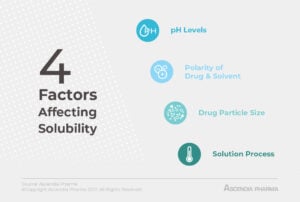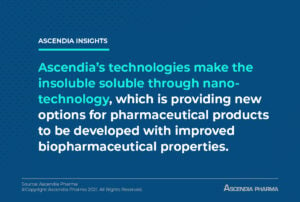4 Factors Affecting Solubility of Drugs
Bringing a new drug—or a new formula—to market is an exciting time for pharmaceutical companies, but getting the formulation correct can be challenging. Low aqueous solubility is a top concern encountered with formulation development of new chemical entities (NCEs). Improper drug solubility can lead to suboptimal drug delivery and absorption, resulting in ineffective drug efficacy and side effects. That’s why solubility of drugs must be evaluated in the early stages of drug discovery.
What Is Drug Solubility?
Solubility is the ability for a drug to be dissolved in an aqueous medium. Drug solubility is defined as the maximum concentration of a substance that can be completely dissolved in a given solvent at a certain temperature and pressure level.
Solubility of drugs is measured by the amount of solvent needed to dissolve one gram of the drug at a specific temperature. For example, a drug that is very soluble needs less than one part solvent to dissolve one gram of the drug. How soluble a drug is varies widely—a drug that is considered soluble needs 10-30 parts, one that is slightly soluble needs 100-1,000 parts and one that is practically insoluble or insoluble needs more than 10,000 parts. How soluble a drug is depends on the solvent, as well as temperature and pressure.

Why Is Drug Solubility Important?
Oral dosage is a common drug delivery route thanks to high patient adherence, cost effectiveness, ease of taking the drug, flexibility in design of the dosage and lower sterility constraints. A hurdle, however, is designing and formulating a drug with aqueous solubility, drug permeability, dissolution rate, first-pass metabolism, pre-systemic metabolism and susceptibility to efflux mechanisms. Poor solubility and low permeability are the most frequent barriers of oral bioavailability of drugs.
Drug solubility has one of the highest impacts on the desired concentration of a drug in systemic circulation, and therefore whether or not the drug will have the desired impact or pharmacological response in patients. Drugs that have poor aqueous solubility have a slower drug absorption rate, which can lead to inadequate and variable bioavailability, and render the drug ineffective.

4 Factors Affecting Solubility
- pH Levels — pH measures the amount of hydrogen content in a solution—the more hydrogen ions, the lower the pH and vice versa. Solutions with strong pH levels fully dissociate and those with weak pH levels only partially dissociate. The pKa value is one method used to measure the strength of an acid. A lower pKa value means the drug substance is a stronger acid, which more fully dissociates in water.
- Polarity of Drug and Solvent — Ionization is important for a drug to be soluble for oral drug consumption. In addition, ion trapping is important for the drug to work properly. In the stomach or intestines, the drug is non-ionized so it can be absorbed. When it enters the bloodstream, it needs to become ionized again to prevent it from going back to the GIT and to ensure it is absorbed by the body. Lipid soluble substances contain non-ionized molecules (NaCl), and hydrophilic substances contact ionized molecules (Na+, CL-), meaning the more lipid soluble a drug is, the more absorption there will be. The more water soluble (hydrophilic) a drug is, the less absorption there is.
- Drug Particle Size — The solubility of a drug is directly tied to the particle size. Typically, larger particles are less soluble, especially if the temperature, pressure and polarity for the solutes is the same. The ability for a drug to be soluble allows for simple diffusion of the drug with no energy or carrier protein needed to enter and be absorbed by the bloodstream.
- Solution Process — Most substances are endothermic, or absorb heat in the process of dissolution, meaning an increase in temperature from room-temperature storage to oral consumption and moving into body heat results in an increase in solubility. In addition to temperature, agitation helps increase the speed at which the drug dissolves.
How Does Solubility Affect Drug Absorption?
Drug absorption through an oral dosage relies on disintegration into small molecules which can be dissolved and pass into the aqueous channels for GIT absorption into the bloodstream. Some factors that impact drug absorption include surface area, presence of food for drug binding and blood supply.
In order for a drug to be absorbed, it needs to be lipid soluble to pass through membranes, unless it has an active transport system or the molecules are so small that they can pass through the aqueous channels in the membrane. Drugs that are not soluble enough to move from the stomach and intestines into the bloodstream, may result in low systemic bioavailability and therefore, suboptimal drug performance.
Poor Drug Solubility
Solubility plays a critical role in drug effectiveness. Without it, a drug substance cannot be absorbed, leading to low bioavailability. Poor solubility of drugs also leads to other issues, such as challenges with metabolism or permeability, interactions with other drugs or the need to extend drug release.
While scrapping your drug and developing completely new drugs is one option, introducing new technology or formulations reduces risk and cost and helps adhere to drug development timelines.
That’s where nanotization comes in.
You may be able to improve dissolution rates of poorly soluble drugs by producing drug nanoparticles with a mean particle size below 1 μm. Nanoparticles are able to dissolve more quickly and can also cross a number of biological barriers, including BBB, different types of mucosa and cell membranes.

How Ascendia Pharmaceuticals Can Help
Ascendia’s technologies make the insoluble soluble through nano-technology, which is providing new options for pharmaceutical products to be developed with improved biopharmaceutical properties. Nano-technology in the pharmaceutical field encompasses many types of formulation approaches, from nanoparticles to self-emulsifying lipid systems, to dispersed amorphous systems, to nano-emulsions. Ascendia’s suite of state-of-the-art technologies for formulating poorly water-soluble compounds provide sophisticated formulation options.
Pharma contract development manufacturing companies (CDMOs) that use multiple formulation technologies to address each compound’s unique properties helps aid successful drug development, and Ascendia has three patented IP technologies that address poor solubility and bioavailability:
- NanoSol is for the production of nano-sized drug particles. Formulation of a drug substance in nano-particle form significantly increases the surface area available for dissolution. In fact, a 10-20-fold increase in surface area can be realized by reducing particle size from a micronized drug substance to one that is nanonized.
- AmorSol is an amorphous solid dispersion technology that greatly improves solubility and dissolution kinetics. It enables pharmaceutical products with enhanced bioavailability, reduced food effect, and more rapid onset-of-action. AmorSol utilizes spray drying, hot-melting extrusion or solvent evaporation to prepare solid dispersion.
- EmulSol is for production of oil-in-water or water-in-oil nano-emulsions. Ascendia produces nano-emulsions using a unique high-shear homogenization process that uses no organic co-solvents, and a minimal amount of surfactant excipients. It can greatly reduce the irritation and injection site pain for a parenterally delivered product.
Ascendia Pharmaceuticals is a CDMO that specializes in the invention and development of specialty pharmaceutical products and novel formulation technologies, providing pharmaceutical companies with rapid, comprehensive and cost-effective solutions. We’re ready to hit the ground running — so contact us today!

